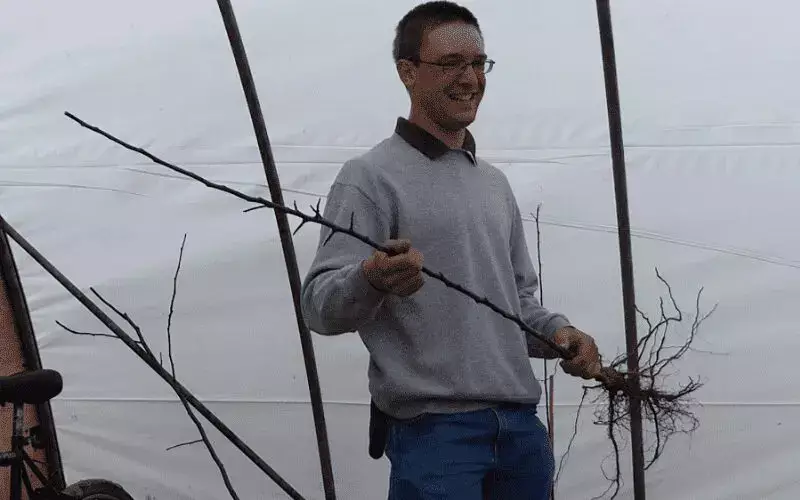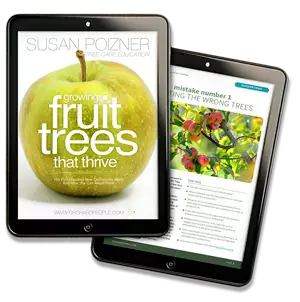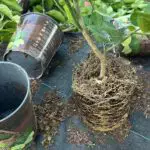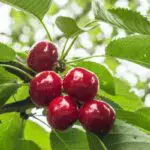How do you choose fruit trees that will work for your landscape? This article and video show you the tips Read more
The Simple Art of Grafting Fruit Trees: A Complete Guide

Why plant 40 different fruit trees when you can grow one single tree that produces 40 different varieties of fruit? In California, there is a fruit tree called the Tree of 40 Fruits, created by Sam Van Aken. On one branch you may find a plum, on another an apricot, and another, a peach, and keep going until you count 40 different varieties of stone fruits.
But how is that possible? Could this tree be from the Garden of Eden? No, this is the simple art of grafting fruit trees. In this article I’m going to discuss what grafting is and why it works. And I'll share 3 methods commonly used to graft fruit trees.
You can learn more in Susan Poizner and Steph Muma's excellent book Fruit Tree Grafting for Everyone or in their award winning online course Complete Fruit Tree Grafting and budding.

grafting fruit trees is not possible without the rootstock and scion
So, how is grafting fruit trees done? Well, just take two trees and fuse them into one. The lower part is called the rootstock and is used to form the roots of the fruit tree. This part of the tree controls how tall the tree will grow. The other section of the graft is the scion, which is used to form the fruiting portion of the tree. A scion is the upper portion of a graft which is responsible for characteristics such as fruit type, flavour and colour.
what is the purpose of grafting fruit trees?
Fruit trees are not usually grown from seed because if they are, the fruit doesn't usually taste very good!
That's because many fruit trees are cross pollinated. Fruit trees have some DNA from the mother tree and some from the father tree.
The resulting seed will have a completely new genetic make-up. And if you plant that seed, the new tree will produce fruit that is nothing like the fruit produced by either parent.
Grafted fruit trees is like an insurance policy that can offer the following benefits:
- They will provide you with a guaranteed variety like Honeycrisp or Gala apples.
- They may offer pest and disease resistance.
- They may be selected to withstand cold climates.
In contrast, fruit trees grown from seed have the following disadvantages.
- They may produce small, sour fruit.
- They may grow to be massive trees.
- They may not produce any fruit at all for up to 7 years.
Did you know that the Macintosh apple trees you see today are growing because someone decided to cut off a small branch and graft it onto another tree to produce the same fruit? The original Macintosh tree dates back to 1811, now that variety is one of the top 10 sold in the world; all because of the simple art of grafting fruit trees.
how does grafting fruit trees work?
When you make a cut into a young fruit tree branch, you’ll notice something interesting. The bark is brown, but the inner tissue is green as you can see in the photo below.
That green layer is the living tissue of the tree which is called the cambium. For a plant to be grafted it must have a cambium. A cambium is an important part of a tree that can be compared to the dividing cells in our body, allowing us continual growth and renewal. We can't graft plants such as grasses because they lack a cambium. But plants with cambiums, like fruit trees, can be grafted quite easily. (Melnyk & Meyerowitz, 2015).

In order to graft a fruit tree, you'll need to make a fresh cut on your scion (which will be the upper part of the tree) and another cut on the rootstock (the bottom part).
You'll then bind the two together. But on the tree's part, it senses that it has been wounded. So the tree sends signals to repair the damage and close the wound. That will secure the two trees together and that graft union will stay intact for the lifetime of the tree.
Many plant hormones are involved in forming the graft union and sealing the exposed tissue (Nanda & Melnyk, 2018).
fruit tree grafting in 7 steps
So, in theory, you know at this point how grafting works. Let's go through the steps you need to take to graft a fruit tree.
Step 1. Collect scionwood in the winter. The cuttings are collected in the dormant season because this is when the plant stops growing and therefore requires far less energy.
Step 2. Ensure the scionwood is disease and pest-free by visually inspecting it for any irregularities. The cutting should be approximately 16” in length and about the diameter of a pencil.
Step 3. Label the scion with the name of the tree and the date of the cutting.
Step 4. Store scionwood safely. The cutting should be wrapped in a damp paper towel and then tucked into a plastic bag. Then place the package in the refrigerator until spring to maintain dormancy. Remove any fruit that is ripening in the refrigerator. Certain fruits produce ethylene as they ripen which can kill the scionwood.
Step 5. Preorder rootstock. Preorder early as rootstock sells out quickly. You may need to order up to 9 months in advance.
Step 6. In the spring, grafting fruit trees can begin. Look outside. If fruit trees in the neighbourhood have buds that are starting to open, you know that the tree's sap is beginning to flow. This is the perfect time for spring fruit tree grafting.
Step 7. Use one of the grafting methods below. Check out some common methods for grafting fruit trees further down in this article.
Once you have chosen a grafting method, you are all set, right? Hold tight, there’s one last important step when grafting fruit trees to consider and that’s making sure your scion and rootstock will get along!

which fruit trees can be grafted together?
Ok, so now that you know how to graft fruit trees, what’s to stop you from getting any old rootstock and sticking a branch from an apple tree on top? Well, that might not work for you. That’s because the rootstock and scion wood need to be compatible.
Rootstocks and scions that belong to the same botanical species are always compatible, so anything that is an apple, can be grafted to another apple.
Rootstocks and scions from different species in the same genus are also usually compatible. An example of this is within the genus Prunus or the stone fruit genus, which includes apricots, peaches, plums, nectarines, cherries and almonds. The Tree of 40 Fruits, which we talked about earlier, is an example of this compatibility and you can listen how that is done in the video below.
However, as you make your way up the taxonomic hierarchy (from Species to Kingdom), the scion and rootstock become more incompatible because there is less similarity between the two.
So, let’s say you want to graft a pear scion onto a quince rootstock. You discover that they are in the same family. Bingo! You think you have found a winning combination!
And sometimes that's true. Certain varieties of pear are compatible with quince root stocks including Anjou, Cornice, Old Home and Flemish Beauty. But other varieties, like Bartlett, Bosc and Seckel are not. You can learn more about which will work, and which will not, in this article.
The problem is that pears and quinces don’t share the same genus. So sometimes, when pear and quince are grafted, a toxin from the quince rootstock enters the pear scion and poisons the graft union, causing it to fail (Pereira et al., 2017). This is just one example of graft incompatibility and why it's important to graft rootstock and scionwood that are closely related.

where to buy rootstock for grafting fruit trees
So, getting the scionwood seems straight forward, right? You have a productive tree in your backyard, and you love the apples, but this tree isn’t going to last forever, so you want to start a new tree just like the one you have. So, you take a cutting and you have the scion, but you’re missing a piece, the rootstock.
You can grow your own rootstock from seed, but here are some of the problems you may encounter:
- The tree will probably be massive.
- The rootstock might not be suited to your climate.
- The rootstock may be sensitive to the pests and disease in your area and may be infected easier.
Your best bet is to find a producer that specializes in growing clonal rootstock. Clonal rootstock is used so that the tree you plant will be adapted to the area you live in and won’t grow to be 40 ft tall.
Your best bet is to find a producer that specializes in growing clonal rootstock.
For apples and pears, producers will grow clonal rootstocks in a stool bed. The rootstock is cut down and sawdust is mounded up around it. This prompts mini-rootstocks to pop up all around the single rootstock you had before. The mini-rootstocks are then separated from the stool bed and grown on their own until they are shipped away to nurseries to be grafted to scions.
Maybe you’ve heard that most peach and nectarine tree rootstocks ARE grown from seed. These are called seedling rootstocks. This is because:
- There has not been much success with breeding smaller versions (dwarfing rootstocks) of these trees.
- Peaches, apricots, nectarines, and sour cherries are self-pollinating, so the seed produced from these trees are very similar to the parent tree.
Finding rootstock for sale can be tricky business, especially if you are not looking to buy enough for an orchard. Most nurseries do not advertise rootstock sales because they sell the trees after they have been grafted. There are a few places like Fedco in the US and Maple Grove Nursery in Canada that sell small amounts of rootstocks for those who want to graft their own apple trees.

grafting fruit trees: techniques
So, now you understand the basic "dos and don’ts" of grafting fruit trees and you are on your way to becoming an orchardist. Now I will introduce you to some of the more common methods used to fuse the fruiting wood to the rootstock.
If you are looking to make an old tree productive again, you may be interested in bark grafting. Choosing between some methods such as the whip and tongue method versus bud grafting, may come down to timing and preference, but both are equally effective for grafting fruit trees.
bark grafting: a way to give old fruit trees a new lease on life
Bark grafting is one method that is used to improve the quality of an old fruit tree or to change the variety on a productive rootstock. For this technique, you peel the bark back to expose the cambium and then insert the scion. In this video below: Patrick Mann, a volunteer from City Fruit in Seattle (Washington, U.S.) demonstrates how simple bark grafting can be; accomplished with only a few supplies.
fits like a puzzle: using the whip and tongue technique
If you like jigsaw puzzles, the whip and tongue technique might be the one to choose. A long slanting cut which provides the maximum surface area between the scion and rootstock, is characteristic of a whip and tongue graft. You’ll need some practice, a sharp knife, elastic bands and some wax. In the video below, Ken Roth, a well seasoned grafting expert from Silver Creek Nursery in Ontario, demonstrates how to perform this quick manoeuvre.
bud grafting: for summer grafters
Did you miss the early season for grafting? It’s not too late! You can graft fruit trees in the late summer but it’s a different technique. The first step is to take a single bud from the desired scion. Next, with your rootstock, ensuring the two are compatible, insert the bud with a T-cut or a chip cut. In the next video, Ken Roth from Silver Creek Nursery, shows you how.
how to keep your newly grafted fruit trees healthy?
Once you've gone to all this trouble of grafting a fruit tree you need to know how to care for it! Here are some tips.
- Keep your tools clean to prevent infection. Your grafting tools can transmit disease as you graft tree after tree. Wipe the blades of your grafting tools with isopropyl alcohol after use to sterilize them.
- Keep the grafting knife sharp. This will make the cut smoother and allow the tree to heal quicker.
- Don’t forget to seal off any exposed green tissue to prevent the cutting from drying out. You can seal off the cuts you made with grafting wax and a rubber band.
Now, you know how to graft your first fruit tree. You have made a tremendous step towards becoming an orchardist. You are on the right track, but don’t stop here. Your fruit tree will need continual care and nurturing. Follow some of the additional resources below to keep your grafted fruit trees in tip top shape.
caring for fruit trees - including pruning, fertility management and pest and disease prevention
Grafting a fruit tree is just the beginning of your journey. Taking care of it to ensure it is healthy and productive is your next step. But how do you do this? Here are some extra resources for you:
- Essential fruit tree care online courses offered through the Orchard People website where you will learn fruit tree pruning, fertility management, pest and disease prevention and more.
- The Orchard People books page, which contains some must reads.
- The North American Fruit Explorers (NAFEX) is a network of people passionate about growing fruit.
Fruit Trees
That Thrive


Shannon McDowell is an intern at OrchardPeople.com. She is a bachelor's student in agricultural science at the University of Guelph, Ontario. She is passionate about gardening and pomology.


